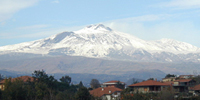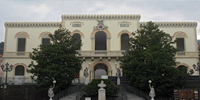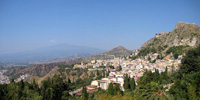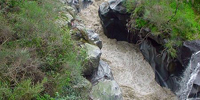Suggested itineraries
ETNA |
CARNEVALE |
ZAFFERANA |
 |
 |
 |
TAORMINA |
GIARDINI NAXOS |
GOLE ALCANTARA |
 |
 |
 |
ZAFFERANA
Since the early days of Roman occupation, the Zafferana Etnea area was crossed by an important axis that connected the town of Tauromenium to that of Katane, providing an alternative route to via Consolare Valeria that ran along the Ionian coast. This road facilitated the movement of Roman soldiers to guard against enemy attacks and allowed to reach the forests of Etna, whose wood was used for shipbuilding.
In this regard, in his Library of folk traditions, the renowned anthropologist Palermo Giuseppe Pitrè cites Zafferana as the passage of the three saints Alfio, Cirino and Philadelphus. They were led by Tertullo da Tauromenium to Leontini to be martyred on 10th May 253. Some sources claim that, on that occasion, an eruption of Etna made the coast road (Via Valeria) inaccessible, forcing the legion and the condemned to use the Etna road.
A small part of this ancient paved road, that was later converted into a mule track and used until the beginning of the last century, is still visible nearby the Contrada Dagalone. Another testimony to the presence of the Romans in the region is represented by the discovery of some Roman coins.
Due to the eruptions of Etna and the earthquakes that repeatedly devastated the area, there is no other historical evidence before the Noto Valley earthquake in 1693.
The history of the present population centre has its origins with the foundation of the priorship of
St. James (San Giacomo). Built in medieval times, the Benedictine monastery is first mentioned in a document signed by Simone del Pozzo, the Bishop of Catania, starting from 1387. A bull of Pope Eugene IV, signed in 1443, mentions the existence of a church dedicated to Saint James, which is presumed to be attended not only by a first group of people settling around the monastery, but also by many pilgrims rushing to celebrate St. James's Day, on 25thJuly. Monastic life ended in 1464, but the church was opened for worship until at least 1677. Then it was probably destroyed, along with the entire complex, by the terrible earthquake of 1693. The Priory was located at the entrance of San Giacomo Valley, upstream of the modern town.
Some scholars of hagiography argue that, in the Zafferana area, a first small monastery was founded by St. Sabinus (died 15 October 760), bishop of Catania, who left the administration of the diocese and retired to a secluded place with his disciples. This fact is not supported by reliable sources and it is hasty to assume that the Priory of St James could have arisen later on the original monastery of St. Sabinus.
The first toponym that appeared in the history of Zafferana is "Cella". It indicated Saint James’s area, where the priory was located. Instead, the toponym "Zafarana", which then gave the village its name, appeared for the first time in a document of 1694. The lands of the Contrada Zafarana came under the control of the municipalities of Trecastagni, Viagrande and Aci San Antonio until 1826. While, from a religious point of view, the village church (church of Madonna della Provvidenza), built in the early eighteenth century, was linked with the parish archpriesthood "Saint Nicolas of Bari" of Trecastagni until the establishment of the parish (1753).
On 21th September 1826, a decree of Francis I ordered the districts of Zafarana Etnea, Sarro, Rocca d'Api, Bongiardo and Pisano to form a new municipality under the name of Zafarana Etnea, later called Zafferana Etnea, detaching them from the municipalities of Trecastagni, Viagrande and Aci SS. Antonio e Filippo. Then the other hamlets Fleri (1851) and Petrulli (1951) joined this new municipality, while in 1934 the hamlet Bongiardo passed to the newly formed township of Santa Venerina.










 Contact
Contact

 Gallery
Gallery